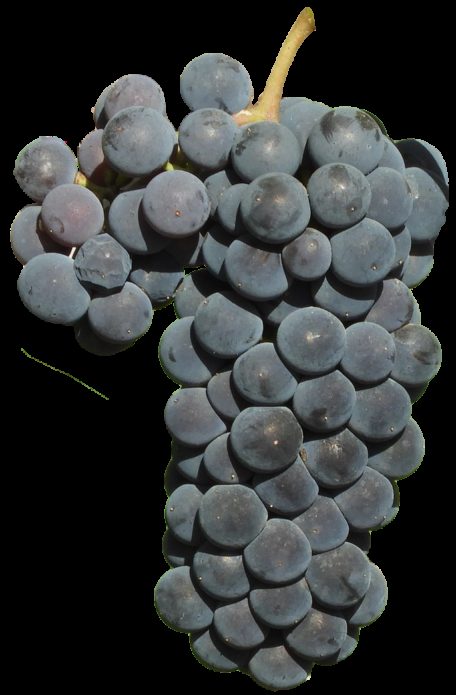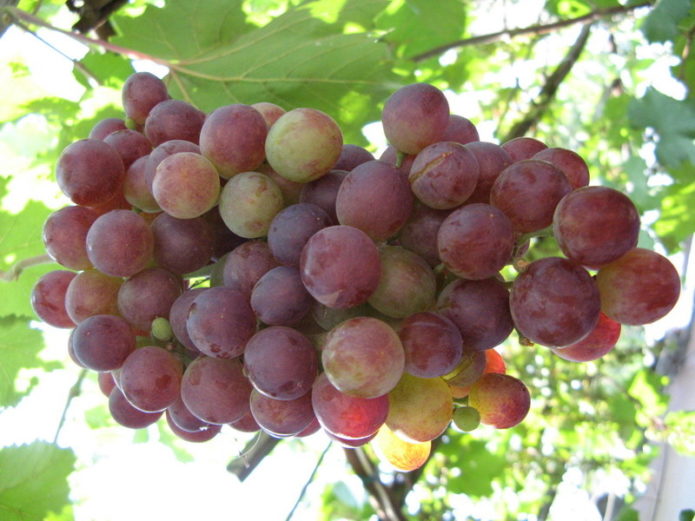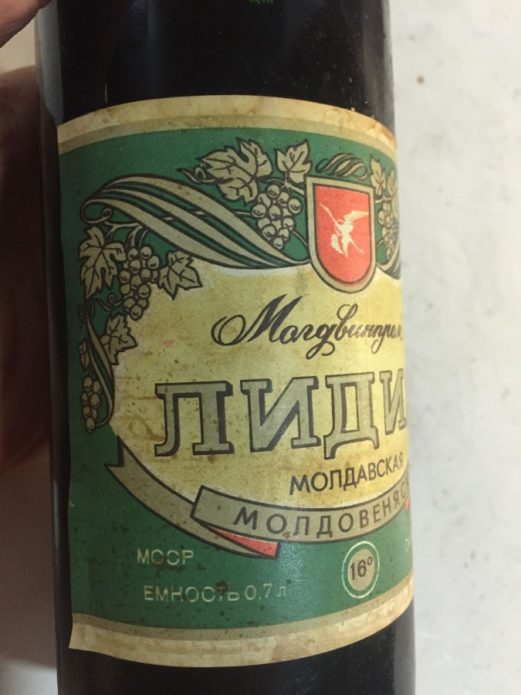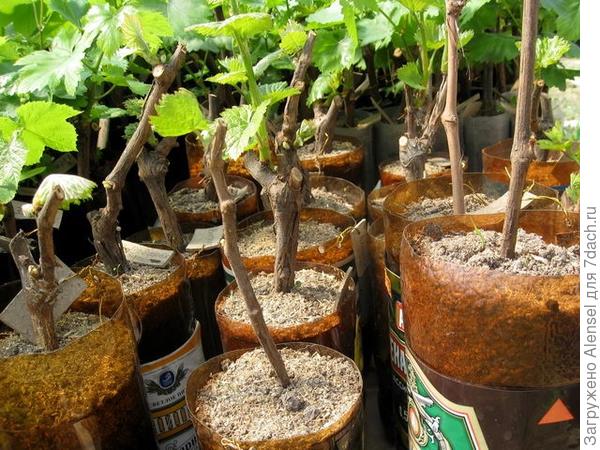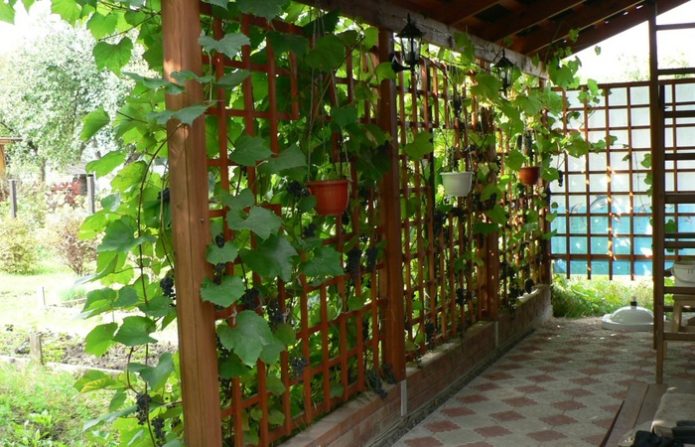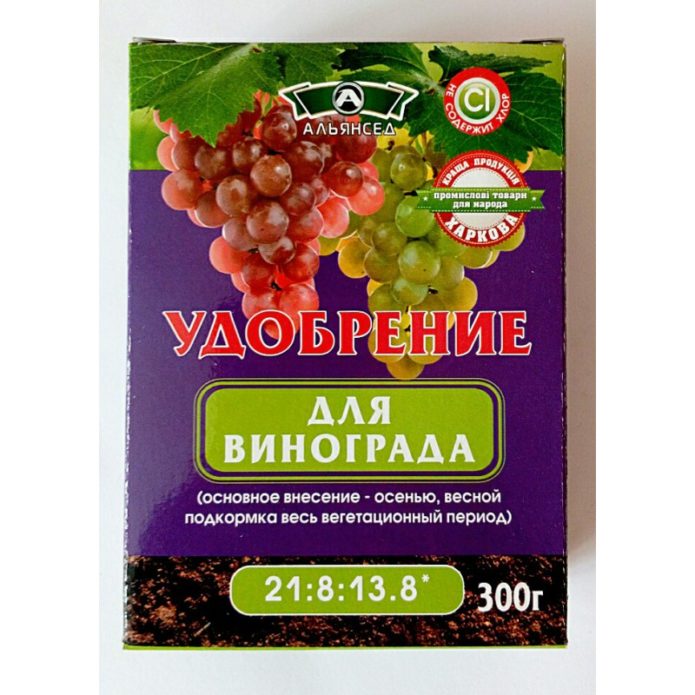Fewer and fewer summer residents are planting good old Lydia grapes on their land. It was replaced by new varieties bearing much more tasty berries, giving a large harvest and at the same time being no less winter-hardy and unpretentious. Lydia remains in the gardens of her ardent adherents and lovers of wine with a specific aroma. Let's try to say a few words in her defense.
Content
Breeding history, description and characteristics of the Lydia grape variety
Lydia is, first of all, a technical grape variety, although many consider it a table grape as well, but the taste of the berries is clearly not for everybody's taste. It originated from North America, isolated from seedlings of the species V. Labrusca, and belongs to the group of isabelle varieties. Moreover, sometimes he is called Isabella pink or Isabella red, although Lydia is not very similar to the real Isabella: both in the appearance and taste of the berries, and in the shape of the bush.
The popularity of Lydia in our country reached its maximum in the middle of the last century, then significant areas in the wine-making regions were allocated for it: its unpretentiousness and interesting aroma led to the fact that wine from this grape was produced in large quantities. However, at the end of the twentieth century, an increased content of methyl alcohol was allegedly found in wine materials from Lydia and from Isabella, and in most countries these varieties were generally banned.
The issue of methanol is controversial, there are still discussions about whether these wines are really dangerous or whether it is the intrigues of competitors that produce products from other grape varieties.
But, nevertheless, almost all industrial vineyards were cut down over time, and now Lydia remains only in private gardens, where her popularity is slowly fading away. Increasingly, it is planted only for the purpose of landscaping yards, shading gazebos and decorating plots without harvesting.
Lydia's bushes grow rapidly and grow very large, the shoots ripen almost 100%. The leaves are very large, usually green in color, slightly dissected, but have significant pubescence. The bushes thicken strongly, therefore, if they are grown for harvest, they require serious pruning and pinching.
In the southern regions, bushes hibernate without shelter, with growing grapes in the middle lane light cover is essential. Frost resistance is significantly higher than that of most European varieties. Resistance against fungal diseases is so high that even preventive spraying is not required, but the variety is defenseless against phylloxera. Easily tolerates severe waterlogging.
The flowers are bisexual, the presence of pollinators is not required, the yield is high: more than 40 kg of berries can be harvested from the bush. The crop ripens late: after budding, at least five months are required, therefore, in the middle lane, the full readiness of the crop for harvest falls already under the beginning of frost, by October. Sometimes in the central regions Lydia does not have time to fully mature at all.But the berries ripen unevenly: when the bunches in the sun are already completely ready, those hanging in the shade may still be green and inedible. One shoot pulls up to five bunches, if more, ripening is not guaranteed.
Lydia achieves her high yield by being able to withstand a large number of bunches, since the bunches themselves are small. They are loose, branched, usually conical or cylindro-conical in shape, but rarely exceed a mass of 100 g. The berries hold well in them only until the moment of average ripening, and then begin to come off even under the influence of strong winds. For this reason, the harvest cannot be delayed.
The berries are perfectly round, medium or below average in size, dark red, sometimes even brownish in color, with a lilac wax bloom. The skin is dense, which interferes with their use. But even more disturbing is the fact that the bones are poorly separated from the mucous pulp, and each berry has to be chewed for a long time in the mouth to get rid of them. The pulp has a specific aroma, somewhat reminiscent of strawberry. The strawberry also resembles the taste of berries, which have a high sugar content (when fully ripe - up to 19%) and variable acidity: from 5.5 to 9 g / l.
Despite the fact that many consider this grape not only technical, but also table one, one can argue with this. The taste is not to everyone's liking, and the difficulties in separating the seeds reduce its table purpose to a minimum.
Good juice is obtained from Lydia, it can be processed into winter compotes, you can even dry raisins. But mainly various wines are made from it.
The Isabella grape is firmly associated with the aromatic red wine of the same name. As for the plant itself, they say: it grows like a weed, does not require care, but it yields yields every year, grows in all regions of Russia:https://flowers.bigbadmole.com/en/yagody/vinograd/vinograd-izabella-opisanie-sorta-foto-otzyivyi.html
Video: Lydia wine grapes on the bushes
Features of planting and growing grape varieties Lydia
Often Lydia is grafted into a different sort of stem, but this is an activity for amateurs. Although, of course, if you set yourself the goal of getting only a small amount of berries, you can graft the cutting into one of the shoots of another adult bush, leaving the rest "as is."
Planting Lydia grapes in spring
For planting in order to grow crops, it is necessary to leave a distance of at least 2-2.5 meters between the bushes, and if Lydia is supposed to be a decorative element of the site, the bushes can be placed every meter. Ideally, the grapes are planted as follows.
The best soil for grapes is black soil, rich in nutrients, but, recall, Lydia can grow on any soil. For landing, you need to choose a sunny area, closed from cold winds, especially the northern direction. A tall house or a solid fence can serve as protection from the winds. Lydia very quickly reaches for the sun, but for the ripening of a high-quality crop, the shoots will have to be placed, including horizontally, so you must immediately provide a strong trellis.
The vines begin to tie on the trellis after the threat of strong spring frosts has passed, at the beginning of sap flow, but before the buds open: https://flowers.bigbadmole.com/en/yagody/vinograd/kak-podvyazyvat-vinograd-vesnoy.html
The seedling must be chosen so that it has well-developed roots. In the south, grapes are planted both in spring and autumn, in the middle lane, it is advisable to do this in the spring, before the May holidays. In advance, you need to dig up the site, adding fertilizer to it, and in the fall, dig a planting hole. A pit is dug with dimensions of 70 x 70 cm or more. A drainage layer (gravel or pebbles) is placed at the bottom and a pipe is drawn to the bottom for watering the roots in the first two to three years. The bottom layer in the pit is fertilized fertile soil, and above it, the soil is clean, without fertilizers. Grapes are planted in the spring deeply, but so that the young roots are in clean soil. 1-2 buds are left on the surface, watered, mulched.
Lidia grape care
Caring for Lydia is elementary, it consists of watering, feeding and pruning. Preventive spraying is required only in unfavorable climatic regions and in the presence of nearby foci of grape diseases. Perhaps the most difficult thing is qualified pruning, the rest of the operations are familiar even to a novice gardener.
Watering is needed rarely, stagnation of water is undesirable, but Lydia, unlike most other varieties, copes well with accidental flooding without falling ill with fungal diseases. The greatest need for watering is during the growth of berries, and by September, watering Lydia must be stopped. Usually, sub-winter watering is also required, especially if the autumn is not too rainy.
It is generally recommended to feed it with ash: annually bury 1-2 liters under the bush. After a year, humus is introduced, it is introduced into small grooves. If you want to get a good harvest, foliar dressing should also be carried out by spraying the leaves. Before flowering and immediately after it, it is convenient to use weak solutions of mineral complex fertilizers, and then nitrogen is excluded from the formulation.
Lydia has a very high resistance to grape diseases, but in problem areas it is advisable to spray with a solution of ferrous sulfate in early spring. Along the green cone, that is, at the moment the buds begin to open, you can treat the bushes with 1% Bordeaux liquid.
Lydia does not wake up very early in spring, so in April you can still have time to prune before sap flow begins. But it is more convenient to do this in the fall, after leaf fall. In the summer, it is necessary to constantly break out excess green shoots and stepchildren while they are young. Stepping is carried out as early as possible, one sheet is left on each stepson. Rationing of the harvest (breaking out part of the bunches) is not required for Lydia: she pulls out everything that has been born. Pruning in spring or autumn is usually medium, 6-8 eyes.
In the southern regions, Lydia does not need to be sheltered for the winter, but in the middle lane, light shelter is required. However, even in a harsh climate, it is enough to remove the vine from the supports before the onset of frost and spread the shoots on the ground so that it is convenient to cover them, and then spread spruce branches of coniferous trees over them.
Even despite the appearance of non-covering varieties, most need to be covered for the winter:https://flowers.bigbadmole.com/en/yagody/vinograd/kak-ukryvat-vinograd-na-zimu.html
Advantages and disadvantages of the variety in comparison with similar
As we have already found out, the Lydia grape variety is specific and is slowly going down in history. Therefore, it can be compared, probably, with similar varieties, of which there are not so many. If we talk about most modern "wine", that is, technical varieties grown in wine-growing regions, then, of course, Lydia loses to them in most consumer parameters, gaining in unpretentiousness, including in the degree of winter hardiness.
If we compare Lydia with Isabella, then the situation here is somewhat different. Isabella grape as a table variety is not quoted at all, while many people use Lydia fresh, albeit in small quantities. But in terms of winter hardiness and the required level of agricultural technology, Isabella is a more “wild” grape, which almost does not require careful care.
The main advantages of Lydia grapes are as follows:
- the variety is unpretentious, grows on any soil, requires minimal care;
- most grape diseases bypass Lydia;
- the variety is very frost-hardy: even in the central regions it requires only light shelter;
- the buncation of flowers allows you to do without pollinating bushes;
- berries do not crack in high humidity conditions;
- the clusters are transportable and well stored;
- some amateurs cite a very specific taste and aroma of berries as an advantage, which is absent in other varieties, but this is a matter of choice.
Since the variety goes down in history, it is clear that it has many disadvantages. The most critical ones are:
- strong susceptibility to bushes by phylloxera;
- the need for strong pruning;
- poor preservation of ripe berries on the bushes;
- difficulty in using fresh berries, associated with poor separation of seeds from the pulp;
- toxic substances found in wine from Lydia by a number of laboratories.
Video: description of the variety Lydia
Reviews
Ripens in the conditions of Kharkov - mid or late September. But I begin to pinch the first ripe berries in the 20th of August. A very unpretentious variety and has never been processed by anything, although the first bush has been growing for forty years. Last year I was hit by mildew, but not critical, because the vine is ripe and gave a good harvest. And the wine made from it is not bad. Quite a worthy variety for lazy people.
I did a blend with alpha, it clears well, the tartar falls out well and quickly. Aroma from Lydia, color from alpha, tastes softer. In short, many times better than mono from Lydia and mono from Alpha.
What surprises me with Lydia? So this is the ripening rate of the berries. Just 2 weeks ago, the berries were emerald green, and now they are dark pink, tasty, and the sugar content is above 20.
Lydia grows in two places and both places in the shade, on the north side of the fence in one place, next to Bako and on the north side of the canopy, which is above the well, with one sleeve “pulled out to the east side of this canopy. The vine is stretched along the top, lowered down and tied up about a meter above the ground. The female tribe is very fond of its aroma and sweetness. I keep it on the bushes, like all grapes, to the last opportunity. It is a pity that Lydia does not hold well on the gronkas, overripe crumbles from the slightest touch.
The Lydia grape is considered a technical grape, although some experts classify it as a table and technical grape. Its main application is winemaking, but in recent years this area of use of Lydia has been sharply reduced. The plantations of this variety are also declining in general. For cultivation in summer cottages, it is of interest, including as a decorative element of the garden, since it requires minimal maintenance.
